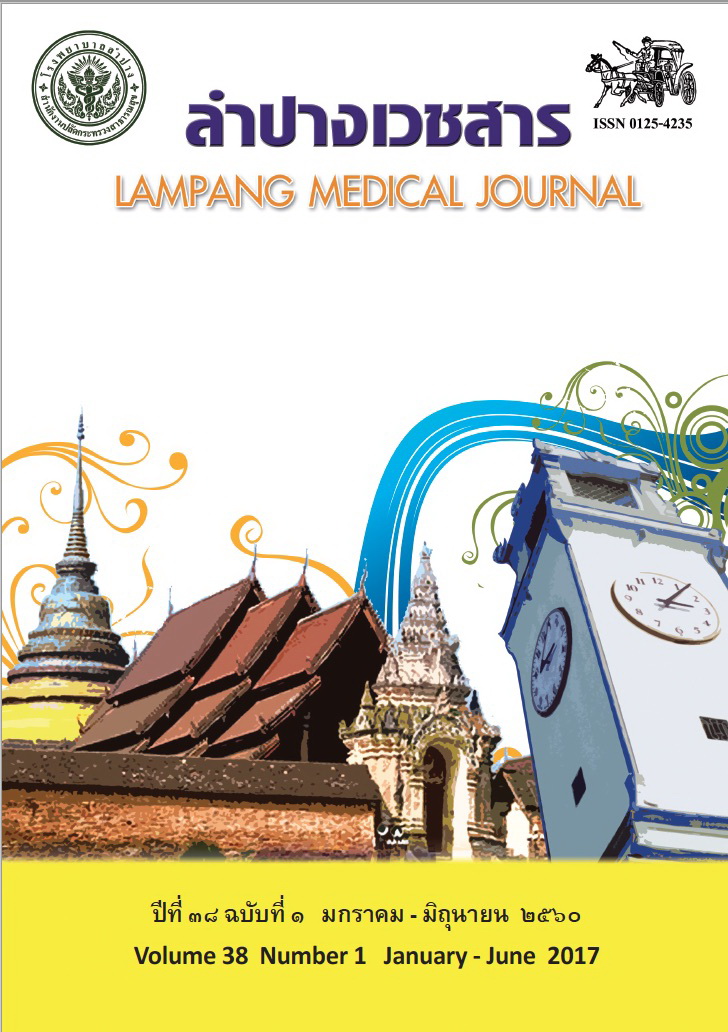Open Pulmonary Thromboembolectomy in Lampang Hospital
Main Article Content
Abstract
Background: Acute massive pulmonary thromboembolism is a rare emergent condition that cause sudden hypoxemia, right ventricular failure and death. Open pulmonary thromboembolectomy is indicated in the patient with hemodynamic instability or unsuitable for medical treatment.
Objective: To determine the surgical outcomes of open pulmonary thromboembolectomy in patients with acute massive pulmonary thromboembolism treated in Lampang Hospital.
Material and methods: A retrospective study was conducted on four consecutive patients (1 male and 3 female) with acute massive pulmonary thromboembolism who underwent open pulmonary thromboembolectomy in Lampang Hospital between January 2010 - November 2015.
Results: The mean age was 55.8 years (range, 41-68). All patients had risk factors for pulmonary thromboembolism and presented with shock. Pulmonary thromboembolectomy was performed in all patients under cardiopulmonary bypass. Postoperatively, three patients survived in NYHA functional class I with significantly decreased right ventricular pressure. There was one hospital death (25%) from decompensated shock with renal failure.
Conclusion: Open pulmonary thromboembolectomy is a simple and life-saving procedure with 25% operative mortality rate. Early diagnosis and immediate surgery prior to multi-organ failure may decrease mortality rate.
Article Details
บทความที่ส่งมาลงพิมพ์ต้องไม่เคยพิมพ์หรือกำลังได้รับการพิจารณาตีพิมพ์ในวารสารอื่น เนื้อหาในบทความต้องเป็นผลงานของผู้นิพนธ์เอง ไม่ได้ลอกเลียนหรือตัดทอนจากบทความอื่น โดยไม่ได้รับอนุญาตหรือไม่ได้อ้างอิงอย่างเหมาะสม การแก้ไขหรือให้ข้อมูลเพิ่มเติมแก่กองบรรณาธิการ จะต้องเสร็จสิ้นเป็นที่เรียบร้อยก่อนจะได้รับพิจารณาตีพิมพ์ และบทความที่ตีพิมพ์แล้วเป็นสมบัติ ของลำปางเวชสาร
References
2. Konstantinides SV, Torbicki A, Agnelli G, Danchin N, Fitzmaurice D, Galiè N, et al. 2014 ESC guidelines on the diagnosis and management of acute pulmonary embolism. Eur Heart J 2014;35:3033-69.
3. Jaff MR, McMurtry MS, Archer SL, Cushman M, Goldenberg N, Goldhaber SZ, et al. Management of massive and submassive pulmonary embolism, iliofemoral deep vein
thrombosis, and chronic thromboembolic pulmonary hypertension: a scientific statement from the American Heart Association. Circulation 2011;123:1788-830.
4. Stein PD, Alnas M, Beemath A, Patel NR. Outcome of pulmonary embolectomy. Am J Cardiol 2007;99:421-3.
5. Bĕlohlávek J, Dytrych V, Linhart A. Pulmonary embolism, part I: Epidemiology, risk factors and risk stratification, pathophysiology, clinical presentation, diagnosis and nonthrombotic pulmonary embolism. Exp Clin Cardiol 2013;18:129-38.
6. Heit JA. The epidemiology of venous thromboembolism in the community: implications for prevention and management. J Thromb Thrombolysis 2006;21:23-9.
7. Pineda LA, Hathwar VS, Grant BJ. Clinical suspicion of fatal pulmonary embolism. Chest 2001;120:791-5.
8. Dauphine C, Omari B. Pulmonary embolectomy for acute massive pulmonary embolism. Ann Thorac Surg 2005;79:1240-4.
9. Goldhaber SZ, Visani L, De Rosa M. Acute pulmonary embolism: clinical outcomes in the International Cooperative Pulmonary Embolism Registry (ICOPER). Lancet 1999;353:1386-9.
10. Aymard T, Kadner A, Widmer A, Basciani R, Tevaearai H, Weber A, et al. Massive pulmonary embolism: surgical embolectomy versus thrombolytic therapy--should surgical indications be revisited? Eur J Cardiothorac Surg 2013;43:90-4.
11. Aklog L, Williams CS, Byrne JG, Goldhaber SZ. Acute pulmonary embolectomy: a contemporary approach. Circulation 2002;105:1416-9.
12. Kadner A, Schmidli J, Schönhoff F, Krähenbühl E, Immer F, Carrel T, et al. Excellent outcome after surgical treatment of massive pulmonary embolism in critically ill patients. J Thorac Cardiovasc Surg 2008;136:448-51.


